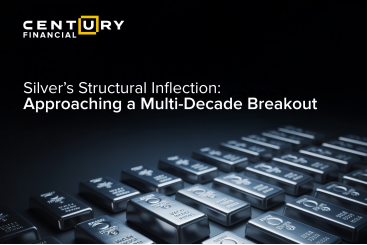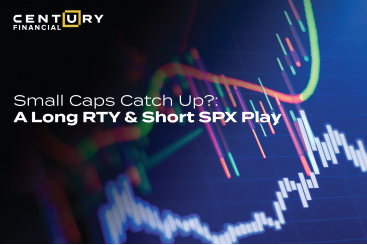Wednesday, May 08, 2024
Volatility As An Asset: Hedging Against Market Downturns With VXX ETN
By Century Financial in 'Investment Insights'

.jpg)
The Case for Volatility Products
Traditional investments can suffer during market swings, as uncertain and downward-trending markets can erode portfolio value. Volatility products can serve as a strategic addition, offering a potential hedge and potentially offsetting losses due to their decently negative correlation with the markets.
Volume and volatility are likely to increase under the following circumstances:
Black Swan Events
Unexpected occurrences such as geopolitical crises or natural disasters can trigger market panic, prompting investors to turn to volatility products for protection.


Economic Downturns
Disappointing economic data or shifts in central bank policies can raise fears of recession, thereby increasing demand for hedges.
Earnings Season Volatility
Periods when companies report earnings can be turbulent. If earnings disappoint, markets can react negatively, thereby boosting the price of volatility products.

By understanding these catalysts for volatility, you can anticipate potential opportunities that can play a valuable role in defending your portfolio.
iPath Series B S&P 500 VIX Short-Term Futures ETN
The VXX ETN, known formally as the iPath Series B S&P 500 VIX Short-Term Futures ETN, is a financial instrument that offers exposure to volatility. It does so by tracking futures contracts on the CBOE Volatility Index (VIX), which is widely considered a barometer of market sentiment and investor uncertainty. The VXX ETN is designed to capture the volatility of the stock market, making it a potentially valuable tool for hedging portfolios or capitalizing on market downturns.
The VXX's performance is closely tied to the VIX index, which measures the market's expectation of volatility over the coming 30 days. When the market anticipates increased volatility, the VXX ETF's value is likely to rise, and conversely, it tends to fall when market volatility is expected to decrease.
The VXX ETN is structured as an Exchange Traded Note (ETN), which means it is an unsecured debt security, unlike traditional ETFs that hold assets like stocks or bonds. This structure allows the VXX to mimic the performance of the VIX futures index closely.
| Ticker | VXX US |
| Issuer Name | iPath Series B S&P 500 VIX Short-Term Futures ETN |
| ISIN | US06748F3249 |
| Inception Date | 17/01/2018 |
| Primary Exchange Name | Cboe BZX |
| Last Price | $15.45 |
| 52W Low | $12.73 |
| 52W High | $43.21 |
| NAV | $15.13 |
| % Premium | -0.36% |
| Total Assets ($ million) | $281.37 |
| Expense Ratio | 0.89% |
| Beta | 0.93 |
| Dividend Yield | N/A |
| Average 30 Day Volume | 19,716,538 |
| 5 Year Annualized Total Return - Current | 48.20% |
| Sharpe Ratio 1Yr | -3.27 |
| Sortino Ratio | -1.53 |
| Return Volatility | 44.51 |
| Downside Risk | 31.47 |
*Last Price as of 17th April 2024
Source: Bloomberg
Scenario Analysis
Based on a historical study of the performance of Equity Index and VXX ETN, the following results were observed. S&P500 was considered as the broad proxy for US markets.
| Time frame (2019 - 2024) | Daily |
| No. of Observations | 1256 |
| No. of 3 consecutive negative returns for SPX | 112 |
| No. of VXX positive returns when SPX was negative for 3 periods | 86 |
| Hit Ratio | 77% |
| Average Return of VXX when SPX was Negative for 3 periods | 2.97% |
*Note: Holding Cost and Dividends are not included in the return calculations
Data as of 17th April 2024
Source: Bloomberg
Regression Analysis between the VXX ETN and S&P500 Index
Data as of 17th April 2024
Chart Source: Bloomberg
The regression analysis reveals a significant historical trend: over the past five years, VXX has consistently displayed a negative correlation with SPX, with a noteworthy correlation coefficient of -0.863. This indicates a strong inverse relationship between the two assets, implying that when the S&P 500 (SPX) experiences declines, VXX tends to rise, and vice versa.
In conclusion, the VXX ETN is a specialized financial instrument that captures market volatility. Its performance is not indicative of the broader market's direction but rather its expected instability.
Note: Past performance is not indicative of and does not guarantee future results. Trading in markets may involve loss of capital.





__1102779201.jpg)




.png)
.png)
.png)
.png)


